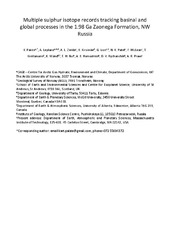| dc.contributor.advisor | Lepland, Aivo | |
| dc.contributor.author | Paiste, Kärt | |
| dc.date.accessioned | 2018-11-19T14:30:07Z | |
| dc.date.available | 2018-11-19T14:30:07Z | |
| dc.date.issued | 2018-11-08 | |
| dc.description.abstract | Earth’s oxygen-rich atmosphere and its capacity to sustain complex life is the most paramount feature that distinguishes Earth from all other planets. The irreversible oxygenation of atmosphere occurred about half way through Earth’s history at ~2.3 Ga (the Great Oxidation Event – GOE) when for the first-time photosynthetic oxygen production surpassed the consumption by chemical reactions allowing it to accumulate in the atmosphere. Consequently, the GOE had a profound impact on the atmosphere-ocean system, intensifying continental weathering, and prompting an increase in the riverine inputs of phosphate, sulfate and metals to the oceans. Increased availability of macro- and micronutrients may have opened new ecological niches to be exploited by complex microbial communities who, in turn, impact biogeochemichal cycles leaving metabolic signatures in the sedimentary rocks. However, there has been significant debate about the exact nature of the GOE, the environmental changes that followed and how these changes are recorded in the rock record.
The focus of this thesis is the ~2.0 Ga Zaonega Formation in the Russian Karelia. This formation is one of the finest archives from which to decipher the physical and chemical conditions, as well as the role of local- vs. global-scale processes in the aftermath of the GOE. The study applies organic carbon and sulfur isotope results to assess organic carbon fluxes, sulfur cycling and depositional conditions that indicate restructuring of the microbial communities at different stages of basin evolution. The results indicate that following the establishment of a substantial seawater sulfate reservoir after the GOE, its size and isotope composition may have remained stable for few 100s Ma. The thesis highlights the importance of evaluating spatial and temporal geochemical variability in the context of individual basinal history before reaching global-scale conclusions. | en_US |
| dc.description.doctoraltype | ph.d. | en_US |
| dc.description.popularabstract | Earth’s O2-rich atmosphere and its capacity to sustain complex life is the most paramount feature that distinguishes Earth from all other planets. Oxygenation of Earth’s atmosphere occurred about half way through its history at ~2.3 Ga (the Great Oxidation Event – GOE) when photosynthetic O2 production surpassed its consumption by chemical reactions. However, there has been significant debate about the environmental changes that followed the GOE and how these changes are recorded in the rock record. The focus of this thesis is the ~2.0 Ga Zaonega Formation, Russian Karelia, which is one of the finest archives from which to decipher environmental conditions in the aftermath of the GOE. The study applies organic carbon and sulfur isotope results to assess the microbial communities and sulfur cycle. The results indicate that following the establishment of a substantial seawater sulfate reservoir after the GOE, its size and isotope composition may have remained stable for few 100s Ma. | en_US |
| dc.description.sponsorship | The research is part of the Centre for Arctic Gas Hydrate, Environment and Climate and was supported by the Research Council of Norway through its Centres of Excellence funding scheme grant No. 223259. | en_US |
| dc.identifier.isbn | 978-82-8236-318-1 (trykt) og 978-82-8236-319-8 (pdf) | |
| dc.identifier.uri | https://hdl.handle.net/10037/14211 | |
| dc.language.iso | eng | en_US |
| dc.publisher | UiT Norges arktiske universitet | en_US |
| dc.publisher | UiT The Arctic University of Norway | en_US |
| dc.relation.haspart | <p>Paper 1: Paiste, K., Lepland, A., Zerkle, A.L., Kirsimäe, K., Izon, G., Patel, N.K. … Prave A.R. (2018). Multiple sulphur isotope records tracking basinal and global processes in the 1.98 Ga Zaonega Formation, NW Russia. (Manuscript). Published version in <i>Chemical Geology, 499</i>, 151-164, available at <a href=https://doi.org/10.1016/j.chemgeo.2018.09.025>https://doi.org/10.1016/j.chemgeo.2018.09.025. </a><p>
<p>Paper 2: Paiste, K., Wing, B.A., Zerkle, A.L., Kirsimäe, K., Pellerin, A., Bui, T.H. … Lepland A. Biogeochemical sulphur cycling in a semirestricted basin – modelling the pyrite multiple sulphur isotope record of the 1.98 Ga Zaonega Formation. (Manuscript). Full text not available in Munin. <p>
<p>Paper 3: Paiste, K., Lepland, A., Zerkle, A.L., Wing, B.A., Kirsimäe, K., Kreitsmann, T. … Prave, A.R. Global vs. basinal controls on Paleoproterozoic sulfur isotope records: new insights from the Zaonega Formation, NW Russia. (Manuscript). Full text not available in Munin.<p> | en_US |
| dc.rights.accessRights | openAccess | en_US |
| dc.rights.holder | Copyright 2018 The Author(s) | |
| dc.rights.uri | https://creativecommons.org/licenses/by-nc-sa/3.0 | en_US |
| dc.rights | Attribution-NonCommercial-ShareAlike 3.0 Unported (CC BY-NC-SA 3.0) | en_US |
| dc.subject | Sulfur isotopes, Organic carbon isotopes | en_US |
| dc.subject | VDP::Mathematics and natural science: 400::Geosciences: 450::Mineralogy, petrology, geochemistry: 462 | en_US |
| dc.subject | VDP::Matematikk og Naturvitenskap: 400::Geofag: 450::Mineralogi, petrologi, geokjemi: 462 | en_US |
| dc.title | Reconstructing the Paleoproterozoic sulfur cycle: Insights from the multiple sulfur isotope record of the Zaonega Formation, Karelia, Russia | en_US |
| dc.type | Doctoral thesis | en_US |
| dc.type | Doktorgradsavhandling | en_US |


 English
English norsk
norsk

